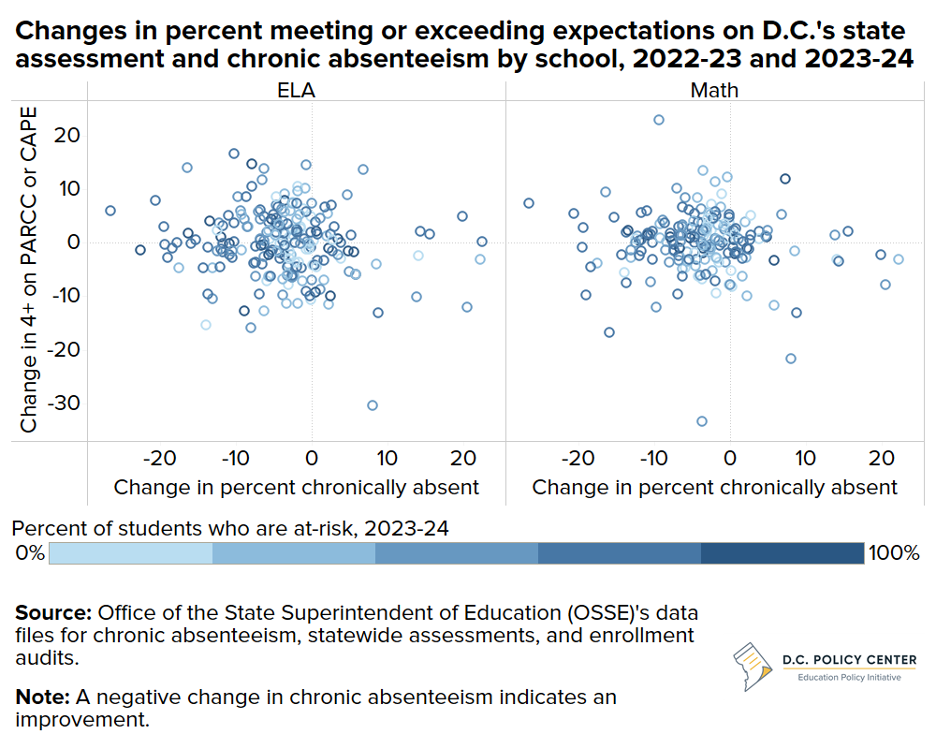
On Wednesday, December 4, 2024, Education Policy Initiative Director Chelsea Coffin testified before the D.C. Council Committee of the Whole at its academic achievement hearing. Her testimony focuses on 2023-24 statewide assessment results, the relationship between chronic absenteeism and achievement, and academic recovery taking some years to show. You can read her testimony below, or download a PDF copy.
The CAPE statewide assessment for school year 2023-241 showed that 34 percent of students met or exceeded expectations in English Language Arts (ELA), and 22.6 percent of student did so in math.2 These results represented small improvements over 2022-23, at 0.3 percentage points in ELA and 0.8 percentage points in math. In both subjects, these changes are lower than the previous year’s annual improvements.3 They are also lower than the typical annual improvements that the city experienced in pre-pandemic years of between 2 and 3 percentage points, signaling that academic recovery from the pandemic is slowing.
At the school level, changes in learning outcomes were mixed. For example, among the 208 schools with learning outcomes data in ELA for the past two years, 31 schools (about one in six) were within one percentage point of their scores from last year, experiencing small changes. 89 schools had improvements greater than 1 percentage point (a similar number of schools saw declines of the same magnitude). Results were similar for math.4 This shows that in addition to very little change at the systems level, schools on the whole are not experiencing large gains.

As in previous years, there is a strong relationship between chronic absenteeism and learning outcomes. Variations in chronic absenteeism can explain 53 percent of the variation in learning outcomes in ELA, and 61 percent of variation in learning outcomes in math. This suggests that improving chronic absenteeism should have a profound impact on learning outcomes. But it turns out this is not really the case.

Across all of D.C.’s public schools last year, chronic absenteeism improved by 4 percentage points and most schools improved by at least 1 percentage point.5 However, the correlation between changes in chronic absenteeism and changes in learning outcomes is very weak. This suggests that just improving chronic absenteeism is not sufficient—there is a real need to improve attendance above a certain threshold, through the commitment to cut chronic absenteeism in half, for example. In addition, there are many other school-level factors influencing learning outcomes, including better supporting students who are designated as at-risk.

Building academic success takes years, and any improvements in attendance will contribute to improving learning outcomes over the longer term.
Endnotes
- Beginning in school year 2023-24, D.C. has implemented a new name for its general statewide assessment system, which includes assessments in English language arts/literacy (ELA), mathematics and science. The CAPE assessment replaces the PARCC assessment, and is comparable across years.
- Office of the State Superintendent of Education (OSSE). 2024. “2023-24 Statewide Assessment Results and Resources.” OSSE. Retrieved from https://osse.dc.gov/node/1728216
- Coffin, C. 2023. “Chart of the week: New PARCC data show overall gain for DC students last year—but high school progress remained flat.” D.C. Policy Center. Retrieved from https://www.dcpolicycenter.org/publications/parcc-data-gains/
- In math, the picture is similar, with 33 schools out of 188 with data for both years within one percentage point of last year, and 52 improving in the same amount as last year (2.6 percentage points), and 49 schools experiencing declines in the same amount.
- Coffin, C. 2024. “Chart of the week: Chronic absenteeism is still improving as of March 2024, with uptick from fall.” D.C. Policy Center. Retrieved from https://www.dcpolicycenter.org/publications/chart-of-the-week-chronic-absenteeism-still-improving-as-of-march-2024/
